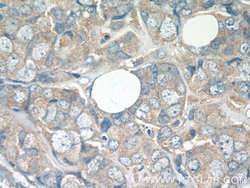Antibody data
- Antibody Data
- Antigen structure
- References [12]
- Comments [0]
- Validations
- Western blot [1]
- Immunohistochemistry [1]
Submit
Validation data
Reference
Comment
Report error
- Product number
- 14834-1-AP - Provider product page

- Provider
- Proteintech Group
- Proper citation
- Proteintech Cat#14834-1-AP, RRID:AB_10694139
- Product name
- ATF2-Specific antibody
- Antibody type
- Polyclonal
- Description
- KD/KO validated ATF2-Specific antibody (Cat. #14834-1-AP) is a rabbit polyclonal antibody that shows reactivity with human, mouse, rat and has been validated for the following applications: IHC, WB,ELISA.
- Reactivity
- Human, Mouse, Rat
- Host
- Rabbit
- Conjugate
- Unconjugated
- Isotype
- IgG
- Vial size
- 20ul, 150ul
Submitted references A druggable copper-signalling pathway that drives inflammation.
Downregulation of AC092894.1 promotes oxaliplatin resistance in colorectal cancer via the USP3/AR/RASGRP3 axis.
Hepatocyte-derived MASP1-enriched small extracellular vesicles activate HSCs to promote liver fibrosis.
Divergent transcriptional regulation of astrocyte reactivity across disorders.
Effect of resistance training on satellite cells in old mice - a transcriptome study : implications for sarcopenia.
Echinococcus multilocularis drives the polarization of macrophages by regulating the RhoA-MAPK signaling pathway and thus affects liver fibrosis.
SET8 participates in lipopolysaccharide-mediated BV2 cell inflammation via modulation of TICAM-2 expression.
Molecular mechanism of miR-204 regulates proliferation, apoptosis and autophagy of cervical cancer cells by targeting ATF2.
Maternal Protein Restriction Induces Alterations in Hepatic Unfolded Protein Response-Related Molecules in Adult Rat Offspring.
Cold-Inducible SIRT6 Regulates Thermogenesis of Brown and Beige Fat.
ATF2 predicts poor prognosis and promotes malignant phenotypes in renal cell carcinoma.
MicroRNA-26b inhibits hepatitis B virus transcription and replication by targeting the host factor CHORDC1 protein.
Solier S, Müller S, Cañeque T, Versini A, Mansart A, Sindikubwabo F, Baron L, Emam L, Gestraud P, Pantoș GD, Gandon V, Gaillet C, Wu TD, Dingli F, Loew D, Baulande S, Durand S, Sencio V, Robil C, Trottein F, Péricat D, Näser E, Cougoule C, Meunier E, Bègue AL, Salmon H, Manel N, Puisieux A, Watson S, Dawson MA, Servant N, Kroemer G, Annane D, Rodriguez R
Nature 2023 May;617(7960):386-394
Nature 2023 May;617(7960):386-394
Downregulation of AC092894.1 promotes oxaliplatin resistance in colorectal cancer via the USP3/AR/RASGRP3 axis.
Zheng Z, Wu M, Li H, Xu W, Yang M, Pan K, Ni Y, Jiang T, Zheng H, Jin X, Zhang Y, Ding L, Fu J
BMC medicine 2023 Apr 3;21(1):132
BMC medicine 2023 Apr 3;21(1):132
Hepatocyte-derived MASP1-enriched small extracellular vesicles activate HSCs to promote liver fibrosis.
Liu X, Tan S, Liu H, Jiang J, Wang X, Li L, Wu B
Hepatology (Baltimore, Md.) 2023 Apr 1;77(4):1181-1197
Hepatology (Baltimore, Md.) 2023 Apr 1;77(4):1181-1197
Divergent transcriptional regulation of astrocyte reactivity across disorders.
Burda JE, O'Shea TM, Ao Y, Suresh KB, Wang S, Bernstein AM, Chandra A, Deverasetty S, Kawaguchi R, Kim JH, McCallum S, Rogers A, Wahane S, Sofroniew MV
Nature 2022 Jun;606(7914):557-564
Nature 2022 Jun;606(7914):557-564
Effect of resistance training on satellite cells in old mice - a transcriptome study : implications for sarcopenia.
Hsu WB, Lin SJ, Hung JS, Chen MH, Lin CY, Hsu WH, Hsu WR
Bone & joint research 2022 Feb;11(2):121-133
Bone & joint research 2022 Feb;11(2):121-133
Echinococcus multilocularis drives the polarization of macrophages by regulating the RhoA-MAPK signaling pathway and thus affects liver fibrosis.
Chong S, Chen G, Dang Z, Niu F, Zhang L, Ma H, Zhao Y
Bioengineered 2022 Apr;13(4):8747-8758
Bioengineered 2022 Apr;13(4):8747-8758
SET8 participates in lipopolysaccharide-mediated BV2 cell inflammation via modulation of TICAM-2 expression.
Zhao Y, Yang X, Meng F, Li W
Canadian journal of physiology and pharmacology 2020 Nov;98(11):818-825
Canadian journal of physiology and pharmacology 2020 Nov;98(11):818-825
Molecular mechanism of miR-204 regulates proliferation, apoptosis and autophagy of cervical cancer cells by targeting ATF2.
Li N, Guo X, Liu L, Wang L, Cheng R
Artificial cells, nanomedicine, and biotechnology 2019 Dec;47(1):2529-2535
Artificial cells, nanomedicine, and biotechnology 2019 Dec;47(1):2529-2535
Maternal Protein Restriction Induces Alterations in Hepatic Unfolded Protein Response-Related Molecules in Adult Rat Offspring.
Liu X, Wang J, Gao L, Jiao Y, Liu C
Frontiers in endocrinology 2018;9:676
Frontiers in endocrinology 2018;9:676
Cold-Inducible SIRT6 Regulates Thermogenesis of Brown and Beige Fat.
Yao L, Cui X, Chen Q, Yang X, Fang F, Zhang J, Liu G, Jin W, Chang Y
Cell reports 2017 Jul 18;20(3):641-654
Cell reports 2017 Jul 18;20(3):641-654
ATF2 predicts poor prognosis and promotes malignant phenotypes in renal cell carcinoma.
Wu DS, Chen C, Wu ZJ, Liu B, Gao L, Yang Q, Chen W, Chen JM, Bao Y, Qu L, Wang LH
Journal of experimental & clinical cancer research : CR 2016 Jul 4;35(1):108
Journal of experimental & clinical cancer research : CR 2016 Jul 4;35(1):108
MicroRNA-26b inhibits hepatitis B virus transcription and replication by targeting the host factor CHORDC1 protein.
Zhao F, Xu G, Zhou Y, Wang L, Xie J, Ren S, Liu S, Zhu Y
The Journal of biological chemistry 2014 Dec 12;289(50):35029-41
The Journal of biological chemistry 2014 Dec 12;289(50):35029-41
No comments: Submit comment
Supportive validation
- Submitted by
- Proteintech Group (provider)
- Main image

- Experimental details
- HeLa cells were subjected to SDS PAGE followed by western blot with 14834-1-AP(ATF2-Specific antibody) at dilution of 1:600
- Sample type
- cell line
Supportive validation
- Submitted by
- Proteintech Group (provider)
- Main image

- Experimental details
- The ATF2-Specific antibody from Proteintech is a rabbit polyclonal antibody to a peptide of human ATF2-Specific. This antibody recognizes human,mouse,rat antigen. The ATF2-Specific antibody has been validated for the following applications: ELISA, WB, IHC analysis.
 Explore
Explore Validate
Validate Learn
Learn Western blot
Western blot ELISA
ELISA